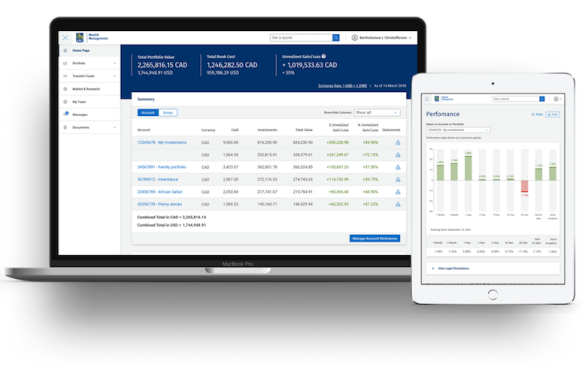In the modern wealth management landscape, digital empowerment has evolved from an operational...
The post‑pandemic decade has pushed digital expectations through the roof. A Deloitte study projects that gen‑AI‑enabled wealth‑tech tools will reach 78 % adoption by 2028, making digital interactions—not office visits—the default touch‑point for investors. Cerulli’s 2024 research echoes the urgency: advisory practices classified as “heavy technology users” out‑performed peers on new‑client growth and AUM expansion by double‑digit margins . In parallel, regulators have sharpened their focus on online engagement. Recent Ontario Securities Commission (OSC) findings highlight that 46 % of Canadians have encountered investment promotions on social media, signaling both opportunity and compliance risk for advisors .
Today’s investor taps a phone at 11 p.m. expecting an instant net‑worth snapshot, a biometric login, and a one‑swipe path to drop a tax slip into a secure vault—no passwords, no printers, no friction. Deliver that “midnight magic” and they’ll reward you with raving CSAT and sky‑high NPS; miss by a single click and they’ll scroll straight to another app before the market opens.
What Exactly Is a “Digital Portal”?
Think of the portal as a single pane of glass—a responsive web/mobile workspace that unifies:
-
Portfolio & performance dashboards
-
Secure messaging & notifications
-
Service tools and actions (money movement, trade approvals, meeting scheduling)
-
Document exchange via an embedded vault
Crucially, the portal is not a monolith; it is a composable layer that surfaces capabilities from your CRM, custodian, planning software, and vault through Single Sign‑On (SSO) and APIs. When done right, neither advisors nor clients feel the seams.
Who Does It Best & Why
RBC Wealth Management Online (Canada)
RBC delivers a bilingual (English/French) interface that meets WCAG 2.1 AA accessibility requirements and aligns with the Accessible Canada Act . Data is processed in RBC‑controlled Canadian data centres and private cloud zones, ensuring compliance with PIPEDA and IIROC guidance on data‑location controls . Notable UX wins include mobile biometric login and the ability for clients to move funds in real time between banking and brokerage accounts .
Lesson: Accessibility and in‑country data residency are differentiators—not afterthoughts.
Charles Schwab Advisor Center (United States)
Schwab offers one‑click SSO into its custodian, trading, planning, and document tools, reducing context‑switching for advisors . As of 2024, two‑factor authentication is mandatory for every user, not just those with trading entitlements. The portal exposes deep APIs that third‑party fintechs consume to embed Schwab data wherever advisors work.
Lesson: SSO + mandatory MFA establishes a security baseline without strangling usability.
Technical & Regulatory Pillars for a Future‑Proof Portal
| Pillar | Why It Matters | Minimum Tech Spec |
|---|---|---|
|
Single Sign‑On (SSO) |
Eliminates password fatigue; enables context‑rich hand‑offs between apps.
|
SAML 2.0 or OIDC with IdP‑initiated flows and token lifetimes <60 min. |
|
Multi‑Factor Authentication (MFA) |
Reduces credential‑stuffing risk by 99%. |
Push notification or FIDO2 passkeys; enforce at every login. |
|
Open APIs & Webhooks |
Drives straight‑through processing (STP) and real‑time alerts. |
REST/JSON, OAuth 2.0, webhooks <2 s latency. |
|
Data Residency Options |
Cross‑border clients may demand local storage. Cloud storage regions help address sovereignty requirements . |
Configurable region selection at tenant level; data in transit via TLS 1.3. |
|
Encryption & Key Management |
SEC Reg S‑P and NI 31‑103 mandate “reasonable safeguards.” |
AES‑256 at rest, TLS 1.3 in transit, field‑level encryption for PII. |
|
Granular Permissions & Audit Trails |
Required for SEC 17a‑4 write‑once‑read‑many (WORM), CIRO3800 and CSA NI-103 s. 11.5 & 11.6 compliance. |
Role‑based access, immutable logs, 7‑year retention. |
|
Privacy & Accessibility Compliance |
ADA (US), AODA (Ontario), GDPR (EU) drive inclusive design. |
WCAG 2.1 AA conformance; VPAT published annually. |
|
Regulatory Alignment |
Books & records regulations, SEC Cybersecurity Rules (2023), CSA guidance (Canada). |
Policy mapping and evidence packs available for audits. |
Why a Digital Vault Is Non‑Negotiable
Documents are the oxygen of wealth advice—KYC forms, trust deeds, tax slips, beneficiary updates. When these flow through email, three failure modes appear:
-
Security – attachments linger in inboxes, violating SEC Reg S‑P encryption expectations.
-
Version Control – multiple drafts create audit confusion.
-
Client Friction – clients resort to printing and scanning.
Embedding a vault inside the portal collapses these gaps. A vault provides immutable versioning, e‑signature hooks, role‑based permissions, and retention policies mapped to global regulations. It turns the portal from a view‑only dashboard into a transactional workspace.
SideDrawer – The Vault Engine You Don’t Have to Build
SideDrawer offers a headless, API‑first digital vault that drops into any portal stack:
-
SSO & MFA: Native SAML/OIDC plus optional passkey support.
-
Data Residency: Choose Canada (Toronto/Calgary), United States, or EU regions at set-up.
-
Collaborator Permission Controls: Pre‑set folder‑level permissions aligned to SEC, IIROC, CSA, and GDPR controls.
-
Accessibility: WCAG 2.1 AA interface and keyboard‑only workflows.
-
Workflow Hooks: Webhooks for e‑sign, DocuSign, or custom triggers.
Business impact: Integrators typically shave 4‑6 months of development and >$250 k in build cost, reallocating resources to client‑facing innovation instead of commodity plumbing.
Best‑Practice Checklist (Print & Pin to Your Board)
-
Portal round‑trip (view statement → upload signed doc) takes ≤ 3 clicks.
-
100 % of logins protected by MFA—no exceptions for “view‑only” users.
-
SSO handshake <1 s; token refresh transparent to users.
-
All PDFs rendered with text‑selectors for screen‑reader compatibility.
-
Region‑pinning configurable per client for multinational households.
-
Audit log exportable in WORM format on demand.
-
Accessibility score ≥ 95 / 100 in automated WCAG testing.
-
Average support tickets per 100 users <2 per month within 90 days post‑launch.
-
Vault SLA ≥ 99.9 %, backed by multi‑AZ deployment.
-
Quarterly penetration tests with remediation tracked in your risk register.
Success Metrics That Actually Move the Needle
Client Outcomes
-
CSAT ≥ 90 % within six months of portal deployment.
-
NPS ≥ +50 (industry median hovers around +34).
-
Digital‑adoption rate ≥ 85 % of clients logging in monthly.
Business Outcomes
-
Onboarding cycle‑time reduced by 30 % (signature to funded accounts).
-
Households per advisor up 25 %, enabled by client self‑service workflows.
-
Cost‑to‑serve down 20 % in first year through fewer manual touches.
These KPIs translate tech investment into board‑level language—growth and margin.
From Portal to Vault, the Architecture of Trust
A portal without an embedded vault is like a high‑rise without elevators: impressive from the street, but exhausting to use. By weaving SSO, MFA, data‑residency controls, and accessibility into a vault‑centric design, firms can meet the dual mandate of better client outcomes and scalable growth.
RBC and Schwab prove that region‑specific compliance and UX excellence are compatible. SideDrawer lets firms of any size replicate those advantages without burning calendars or capital.
Next step: Schedule a 30‑minute SideDrawer demo to see how a headless vault plugs into your existing portal—and start measuring the KPIs that matter.








.png)